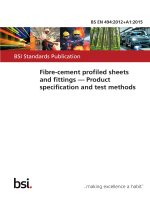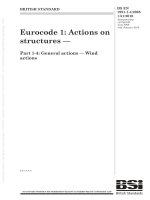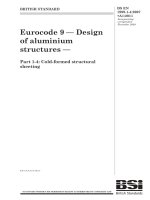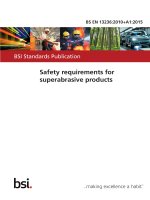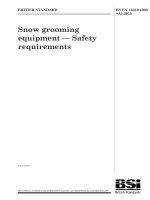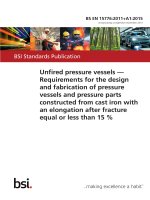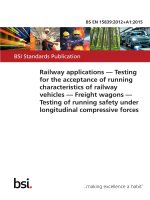Bsi bs en 62325 451 4 2015
Bạn đang xem bản rút gọn của tài liệu. Xem và tải ngay bản đầy đủ của tài liệu tại đây (1.8 MB, 62 trang )
BS EN 62325-451-4:2015
BSI Standards Publication
Framework for energy
market communications
Part 451-4: Settlement and reconciliation
business process, contextual and assembly
models for European market
BRITISH STANDARD
BS EN 62325-451-4:2015
National foreword
This British Standard is the UK implementation of EN 62325-451-4:2015. It
is identical to IEC 62325-451-4:2014.
The UK participation in its preparation was entrusted to Technical
Committee PEL/57, Power systems management and associated
information exchange.
A list of organizations represented on this committee can be obtained on
request to its secretary.
This publication does not purport to include all the necessary provisions of
a contract. Users are responsible for its correct application.
© The British Standards Institution 2015.
Published by BSI Standards Limited 2015
ISBN 978 0 580 85015 8
ICS 33.200
Compliance with a British Standard cannot confer immunity from
legal obligations.
This British Standard was published under the authority of the
Standards Policy and Strategy Committee on 30 April 2015.
Amendments/corrigenda issued since publication
Date
Text affected
BS EN 62325-451-4:2015
EUROPEAN STANDARD
EN 62325-451-4
NORME EUROPÉENNE
EUROPÄISCHE NORM
March 2015
ICS 33.200
English Version
Framework for energy market communications - Part 451-4:
Settlement and reconciliation business process, contextual and
assembly models for European market
(IEC 62325-451-4:2014)
Cadre pour les communications pour le marché de l'énergie
- Partie 451-4: Processus métier de règlement des écarts et
de réconciliation, modèles contextuels et modèles
d'assemblage pour le marché européen
(IEC 62325-451-4:2014)
Kommunikation im Energiemarkt - Teil 451-4: Abwicklungsund Abstimmungsgeschäftsprozesse, kontextbezogene
Modelle und Einbindungsmodelle für den europäischen
Markt
(IEC 62325-451-4:2014)
This European Standard was approved by CENELEC on 2014-12-25. CENELEC members are bound to comply with the CEN/CENELEC
Internal Regulations which stipulate the conditions for giving this European Standard the status of a national standard without any alteration.
Up-to-date lists and bibliographical references concerning such national standards may be obtained on application to the CEN-CENELEC
Management Centre or to any CENELEC member.
This European Standard exists in three official versions (English, French, German). A version in any other language made by translation
under the responsibility of a CENELEC member into its own language and notified to the CEN-CENELEC Management Centre has the
same status as the official versions.
CENELEC members are the national electrotechnical committees of Austria, Belgium, Bulgaria, Croatia, Cyprus, the Czech Republic,
Denmark, Estonia, Finland, Former Yugoslav Republic of Macedonia, France, Germany, Greece, Hungary, Iceland, Ireland, Italy, Latvia,
Lithuania, Luxembourg, Malta, the Netherlands, Norway, Poland, Portugal, Romania, Slovakia, Slovenia, Spain, Sweden, Switzerland,
Turkey and the United Kingdom.
European Committee for Electrotechnical Standardization
Comité Européen de Normalisation Electrotechnique
Europäisches Komitee für Elektrotechnische Normung
CEN-CENELEC Management Centre: Avenue Marnix 17, B-1000 Brussels
© 2015 CENELEC All rights of exploitation in any form and by any means reserved worldwide for CENELEC Members.
Ref. No. EN 62325-451-4:2015 E
BS EN 62325-451-4:2015
EN 62325-451-4:2015
-2-
Foreword
The text of document 57/1449/CDV, future edition 1 of IEC 62325-451-4, prepared by IEC/TC 57
"Power systems management and associated information exchange" was submitted to the IECCENELEC parallel vote and approved by CENELEC as EN 62325-451-4:2015.
The following dates are fixed:
–
latest date by which the document has to be implemented at
national level by publication of an identical national
standard or by endorsement
(dop)
2015-09-27
–
latest date by which the national standards conflicting with
the document have to be withdrawn
(dow)
2017-12-25
Attention is drawn to the possibility that some of the elements of this document may be the subject of
patent rights. CENELEC [and/or CEN] shall not be held responsible for identifying any or all such
patent rights.
Endorsement notice
The text of the International Standard IEC 62325-451-4:2014 was approved by CENELEC as a
European Standard without any modification.
In the official version, for Bibliography, the following notes have to be added for the standards indicated:
IEC 61968-11
NOTE
Harmonized as EN 61968-11.
IEC 61970-301
NOTE
Harmonized as EN 61970-301.
-3-
BS EN 62325-451-4:2015
EN 62325-451-4:2015
Annex ZA
(normative)
Normative references to international publications
with their corresponding European publications
The following documents, in whole or in part, are normatively referenced in this document and are
indispensable for its application. For dated references, only the edition cited applies. For undated
references, the latest edition of the referenced document (including any amendments) applies.
NOTE 1 When an International Publication has been modified by common modifications, indicated by (mod), the relevant
EN/HD applies.
NOTE 2 Up-to-date information on the latest versions of the European Standards listed in this annex is available here:
www.cenelec.eu.
Publication
IEC 62325-301
Year
-
IEC 62325-351
-
IEC 62325-450
2013
IEC 62325-451-1
-
IEC 62325-451-2
-
IEC 62361-100
-
IEC/TS 61970-2
-
Title
EN/HD
Framework
for
energy
marketEN 62325-301
communications -- Part 301: Common
Information Model (CIM) extensions for
markets
Framework
for
energy
marketEN 62325-351
communications -- Part 351: CIM
European market model exchange profile
Framework
for
energy
marketEN 62325-450
communications -- Part 450: Profile and
context modelling rules
Framework
for
energy
marketEN 62325-451-1
communications
-Part
451-1:
Acknowledgement business process and
contextual model for CIM European market
Framework
for
energy
marketEN 62325-451-2
communications -- Part 451-2: Scheduling
business process and contextual models
for European market
Power
systems
managment
andFprEN 62361-100
associated
information
exchange
Interoperability in the long term -- Part 100:
CIM profiles to XML schema mapping
Energy management system applicationCLC/TS 61970-2
program interface (EMS-API) -- Part 2:
Glossary
Year
-
2013
-
-
-
-
–2–
BS EN 62325-451-4:2015
IEC 62325-451-4:2014 © IEC 2014
CONTENTS
INTRODUCTION ..................................................................................................................... 7
1
Scope .............................................................................................................................. 8
2
Normative references ...................................................................................................... 8
3
Terms and definitions ...................................................................................................... 9
4
Document contextual model and message assembly model basic concepts ................... 10
4.1
4.2
4.3
4.4
4.5
5
The
Overview............................................................................................................... 10
European style market package structure ............................................................. 11
From the European style market profile to the document contextual model ........... 13
From the document contextual model to the message assembly model ................. 13
From the assembly model to the XML schema ...................................................... 13
settlement and reconciliation business process ...................................................... 13
5.1
Balance responsible party and settlement ............................................................. 13
5.2
Overall business context ....................................................................................... 16
5.3
Use cases ............................................................................................................. 16
5.4
Process flow ......................................................................................................... 18
5.5
Business rules for the settlement and reconciliation process ................................. 20
5.5.1
General ......................................................................................................... 20
5.5.2
Attributes area_Domain.mRID and domain.mRID and quantity ....................... 21
5.5.3
Dependency matrix for type, processType and businessType ........................ 21
5.5.4
Dependency of attributes of the TimeSeries ................................................... 23
5.5.5
Rules governing the Point class ..................................................................... 23
5.5.6
Attribute price.amount ................................................................................... 23
6
Contextual and assembly models................................................................................... 24
6.1
Energy account contextual model.......................................................................... 24
6.1.1
Overview of the model ................................................................................... 24
6.1.2
IsBasedOn relationships from the European style market profile .................... 26
6.1.3
Detailed Energy account contextual model .................................................... 26
6.2
Energy account assembly model ........................................................................... 35
6.2.1
Overview of the model ................................................................................... 35
6.2.2
IsBasedOn relationships from the European style market profile .................... 36
6.2.3
Detailed Energy account assembly model ...................................................... 36
6.2.4
Datatypes ...................................................................................................... 40
6.2.5
Enumerations ................................................................................................ 47
7
XML schema .................................................................................................................. 48
7.1
7.2
7.3
7.3.1
7.3.2
7.3.3
7.3.4
7.4
XML schema URN namespace rules ..................................................................... 48
Code list URN namespace rules ............................................................................ 48
URI rules for model documentation ....................................................................... 48
Datatype ........................................................................................................ 48
Class ............................................................................................................. 49
Attribute ......................................................................................................... 49
Association end role name ............................................................................. 49
EnergyAccount_MarketDocument schema ............................................................ 50
7.4.1
7.4.2
Schema Structure .......................................................................................... 50
Schema description ....................................................................................... 52
BS EN 62325-451-4:2015
IEC 62325-451-4:2014 © IEC 2014
–3–
Bibliography .......................................................................................................................... 57
Figure 1 – IEC 62325-450 modelling framework .................................................................... 11
Figure 2 – Overview of European style market profile dependency ........................................ 12
Figure 3 – Balance responsible party relations ...................................................................... 15
Figure 4 – Settlement/reconciliation use case ....................................................................... 18
Figure 5 – Sequence diagram of the information flow ............................................................ 19
Figure 6 – Energy account contextual model ......................................................................... 25
Figure 7 – Energy account assembly model .......................................................................... 35
Figure 8 – EnergyAccount_MarketDocument XML schema structure 1/2 ............................... 50
Figure 9 – EnergyAccount_MarketDocument XML schema structure 2/2 ............................... 51
Table 1 – Dependency table for type, processType and businessType .................................. 22
Table 2 – Dependency table for TimeSeries attributes .......................................................... 23
Table 3 – Dependency table for price.amount attribute ......................................................... 24
Table 4 – IsBasedOn dependency......................................................................................... 26
Table 5 – Attributes of Energy account contextual
model::EnergyAccount_MarketDocument .............................................................................. 27
Table 6 – Association ends of Energy account contextual
model::EnergyAccount_MarketDocument with other classes ................................................. 28
Table 7 – Attributes of Energy account contextual model::Currency_Unit .............................. 28
Table 8 – Attributes of Energy account contextual model::Domain ........................................ 29
Table 9 – Attributes of Energy account contextual model::MarketAgreement ......................... 29
Table 10 – Attributes of Energy account contextual model::MarketEvaluationPoint ............... 29
Table 11 – Attributes of Energy account contextual model::MarketParticipant ....................... 30
Table 12 – Association ends of Energy account contextual model::MarketParticipant
with other classes ................................................................................................................. 30
Table 13 – Attributes of Energy account contextual model::MarketRole................................. 30
Table 14 – Attributes of Energy account contextual model::Measure_Unit ............................. 30
Table 15 – Attributes of Energy account contextual model::Party_MarketParticipant ............. 31
Table 16 – Attributes of Energy account contextual model::Point .......................................... 31
Table 17 – Association ends of Energy account contextual model::Point with other
classes ................................................................................................................................. 31
Table 18 – Attributes of Energy account contextual model::Price .......................................... 32
Table 19 – Attributes of Energy account contextual model::Process ...................................... 32
Table 20 – Attributes of Energy account contextual model::Series_Period ............................ 32
Table 21 – Association ends of Energy account contextual model::Series_Period with
other classes ........................................................................................................................ 32
Table 22 – Attributes of Energy account contextual model::Time_Period ............................... 33
Table 23 – Attributes of Energy account contextual model::TimeSeries ................................. 33
Table 24 – Association ends of Energy account contextual model::TimeSeries with
other classes ........................................................................................................................ 34
Table 25 – IsBasedOn dependency ....................................................................................... 36
Table 26 – Attributes of Energy account assembly
model::EnergyAccount_MarketDocument .............................................................................. 37
–4–
BS EN 62325-451-4:2015
IEC 62325-451-4:2014 © IEC 2014
Table 27 – Association ends of Energy account assembly
model::EnergyAccount_MarketDocument with other classes ................................................. 37
Table 28 – Attributes of Energy account assembly model::Point ............................................ 38
Table 29 – Attributes of Energy account assembly model::Series_Period .............................. 38
Table 30 – Association ends of Energy account assembly model::Series_Period with
other classes ........................................................................................................................ 39
Table 31 – Attributes of Energy account assembly model::TimeSeries .................................. 39
Table 32 – Association ends of Energy account assembly model::TimeSeries with
other classes ........................................................................................................................ 40
Table 33 – Attributes of ESMPDataTypes::Action_Status ...................................................... 40
Table 34 – Attributes of ESMPDataTypes::ESMP_DateTimeInterval ..................................... 40
Table 35 – Attributes of ESMPDataTypes::Amount_Decimal ................................................. 40
Table 36 – Restrictions of attributes for ESMPDataTypes::Amount_Decimal ......................... 41
Table 37 – Attributes of ESMPDataTypes::AreaID_String...................................................... 41
Table 38 – Restrictions of attributes for ESMPDataTypes::AreaID_String ............................. 41
Table 39 – Attributes of ESMPDataTypes::BusinessKind_String ........................................... 41
Table 40 – Attributes of ESMPDataTypes::ClassificationKind_String ..................................... 42
Table 41 – Attributes of ESMPDataTypes::CurrencyCode_String .......................................... 42
Table 42 – Attributes of ESMPDataTypes::EnergyProductKind_String .................................. 42
Table 43 – Attributes of ESMPDataTypes::ESMP_DateTime ................................................. 42
Table 44 – Restrictions of attributes for ESMPDataTypes::ESMP_DateTime ......................... 43
Table 45 – Attributes of ESMPDataTypes::ESMPVersion_String ........................................... 43
Table 46 – Restrictions of attributes for ESMPDataTypes::ESMPVersion_String ................... 43
Table 47 – Attributes of ESMPDataTypes::ID_String ............................................................. 44
Table 48 – Restrictions of attributes for ESMPDataTypes::ID_String ..................................... 44
Table 49 – Attributes of ESMPDataTypes::MarketRoleKind_String ........................................ 44
Table 50 – Attributes of ESMPDataTypes::MeasurementPointID_String ................................ 44
Table 51 – Restrictions of attributes for ESMPDataTypes::MeasurementPointID_String ........ 44
Table 52 – Attributes of ESMPDataTypes::MeasurementUnitKind_String .............................. 45
Table 53 – Attributes of ESMPDataTypes::MessageKind_String ........................................... 45
Table 54 – Attributes of ESMPDataTypes::ObjectAggregationKind_String ............................. 45
Table 55 – Attributes of ESMPDataTypes::PartyID_String ..................................................... 45
Table 56 – Restrictions of attributes for ESMPDataTypes::PartyID_String ............................. 46
Table 57 – Attributes of ESMPDataTypes::Position_Integer .................................................. 46
Table 58 – Restrictions of attributes for ESMPDataTypes::Position_Integer .......................... 46
Table 59 – Attributes of ESMPDataTypes::ProcessKind_String ............................................. 46
Table 60 – Attributes of ESMPDataTypes::Status_String ...................................................... 46
Table 61 – Attributes of ESMPDataTypes::YMDHM_DateTime .............................................. 47
Table 62 – Restrictions of attributes for ESMPDataTypes::YMDHM_DateTime ...................... 47
BS EN 62325-451-4:2015
IEC 62325-451-4:2014 © IEC 2014
–7–
INTRODUCTION
This standard is one of the IEC 62325 series which define protocols for deregulated energy
market communications.
The principal objective of the IEC 62325 series of standards is to produce standards which
facilitate the integration of market application software developed independently by different
vendors into a market management system, between market management systems and
market participant systems. This is accomplished by defining message exchanges to enable
these applications or systems access to public data and exchange information independent of
how such information is represented internally.
The common information model (CIM) specifies the basis for the semantics for this message
exchange.
The European style market profile is based on different parts of the CIM IEC standard. The
CIM is defined through a series of standards, i.e. IEC 62325-301, IEC 61970-301 and
IEC 61968-11 standards.
This document provides for the European style market profile the settlement and
reconciliation business process that can be used throughout a European style market. This
standard was originally based upon the work of the European Transmission System Operators
(ETSO) Task Force EDI (Electronic Data Interchange) and then on the work of the European
Network of Transmission System Operators (ENTSO-E) Working Group EDI.
This document describes the settlement and reconciliation process for wholesale markets; it is
brought to the attention of the reader that it is envisaged to initiate work on a combined
reconciliation process for retail and wholesale markets.
–8–
BS EN 62325-451-4:2015
IEC 62325-451-4:2014 © IEC 2014
FRAMEWORK FOR ENERGY MARKET COMMUNICATIONS –
Part 451-4: Settlement and reconciliation business process,
contextual and assembly models for European market
1
Scope
Based on the European style market profile (IEC 62325-351), this part of IEC 62325-451
specifies a package for the settlement and reconciliation business process and the associated
document contextual model, assembly model and XML schema for use within European style
markets.
The relevant aggregate core components (ACCs) defined in IEC 62325-351 have been
contextualised into aggregated business information entities (ABIEs) to satisfy the
requirements of this business process. The contextualised ABIEs have been assembled into
the relevant document contextual models. Related assembly models and XML schema for the
exchange of information between market participants are automatically generated from the
assembled document contextual models.
This International Standard provides a uniform layout for the transmission of aggregated data
in order to settle the electricity market. It is however not the purpose of this International
Standard to define the formula to be taken into account to settle or reconcile a market. The
purpose of this standard is only to enable the information exchange necessary to carry out the
computation of settlement and reconciliation.
The settlement process or reconciliation process is the way to compute the final position of
each market participant as well as its imbalance amounts.
2
Normative references
The following documents, in whole or in part, are normatively referenced in this document and
are indispensable for its application. For dated references, only the edition cited applies. For
undated references, the latest edition of the referenced document (including any
amendments) applies.
IEC TS 61970-2, Energy management system application program interface (EMS-API) –
Part 2: Glossary
IEC 62325-301, Framework for energy market communications – Part 301: Common
information model (CIM) extensions for markets
IEC 62325-351, Framework for energy market communications – Part 351: CIM European
market model exchange profile
IEC 62325-450:2013, Framework for energy market communications – Part 450: Profile and
context modelling rules
IEC 62325-451-1, Framework for energy market communications – Part
Acknowledgement business process and contextual model for CIM European market
451-1:
IEC 62325-451-2, Framework for energy market communications – Part 451-2: Scheduling
business process and contextual model for CIM European market
BS EN 62325-451-4:2015
IEC 62325-451-4:2014 © IEC 2014
–9–
IEC 62361-100, Power systems management and associated information exchange –
Interoperability in the long term – Part 100: CIM profiles to XML schema mapping 1
3
Terms and definitions
For the purposes of this document, the terms and definitions of IEC TS 61970-2 apply, as well
as the following.
NOTE
Refer to IEC 60050, International Electrotechnical Vocabulary, for general glossary definitions.
3.1
aggregate business information entity
ABIE
aggregate business information entity is a re-use of an aggregate core component (ACC) in a
specified business
[SOURCE: ISO/TS 15000-5:2005, Clause 9, modified (modification of the definition)]
3.2
aggregate core component
ACC
collection of related pieces of business information that together convey a distinct business
meaning, independent of any specific business context
Note 1 to entry: Expressed in modelling terms, this is the representation of an object class, independent of any
specific business context.
[SOURCE: ISO/TS 15000-5:2005, Clause 9, modified (modification of the definition)]
3.3
application program interface
API
set of public functions provided by an executable application component for use by other
executable application components
3.4
assembly model
assembly model is a model that prepares information in a business context for assembly into
electronic documents for data interchange
3.5
based on or IsBasedOn
use of an artefact that has been restricted according to the requirements of a specific
business context
[SOURCE: IEC 62325-450:2013, 3.4]
3.6
business context
formal description of a specific business circumstance as identified by the values of a set of
context categories, allowing different business circumstances to be uniquely distinguished
[SOURCE: UN/Cefact, Unified Context Methodology Technical Specification]
___________
1
To be published.
– 10 –
BS EN 62325-451-4:2015
IEC 62325-451-4:2014 © IEC 2014
3.7
European style market profile
ESMP
the European style market profile, the object of this International Standard
3.8
information model
representation of concepts, relationships, constraints, rules, and operations to specify data
semantics for a chosen domain of discourse
Note 1 to entry:
domain context.
It can provide shareable, stable, and organized structure of information requirements for the
3.9
market management system
MMS
computer system comprised of a software platform providing basic support services and a set
of applications providing the functionality needed for the effective management of the
electricity market
Note 1 to entry: These software systems in an electricity market may include support for capacity allocation,
scheduling energy, ancillary or other services, real-time operations and settlements.
3.10
message business information entity
MBIE
aggregation of a set of ABIEs that respects a define set of assembly rules
4
4.1
Document contextual model and message assembly model basic concepts
Overview
IEC 62325-450 defines a set of CIM profiles that follows a layered modelling framework as
outlined in Figure 1 going from the common information model (CIM, IEC 61968-11,
IEC 61970-301 and IEC 62325-301), to different regional contextual models and their
subsequent contextualized documents for information exchange; the final step being the
message specifications for information interchange.
BS EN 62325-451-4:2015
IEC 62325-451-4:2014 © IEC 2014
– 11 –
IEC
Figure 1 – IEC 62325-450 modelling framework
The regional contextual models are the basic core components that are necessary to build
electronic documents for information interchange. This is defined in the European style
market contextual model (IEC 62325-351). These core components are also termed
aggregate core components (ACCs).
A document contextual model is based upon a specific business requirements specification
and is constructed from the contextualisation of the ACCs that can be found in the European
style market contextual model. The contextualised ACCs at this stage are terms aggregate
business information entities (ABIEs) These ABIEs are the constructs that are assembled
together into a specific electronic document to satisfy the information requirements outlined in
the business requirements specification. The transformation from an ACC to an ABIE shall
respect the rules defined in IEC 62325-450.
Once a document contextual model has been built that satisfactorily meets the business
requirements, a message assembly model can be automatically generated from it.
XML schema then may be automatically generated from the message assembly model. If
necessary specific mapping can take place at this stage to transform the CIM class and
attribute names into more market legacy names.
4.2
European style market package structure
Figure 2 describes the main package structure of the European style market profile.
– 12 –
BS EN 62325-451-4:2015
IEC 62325-451-4:2014 © IEC 2014
IEC
Figure 2 – Overview of European style market profile dependency
For each business process, a business process package is described in an IEC 62325-451-x
(x from 1 to n) standard. A business process package contains:
•
The document contextual model (ABIE) and the automatically generated message
assembly model (MBIE) for each electronic document required to enable the completion of
the business process. Each document is a sub contextual model derived by restriction
from the European style market profile.
•
The XML schema of the business document that is automatically generated from the
message assembly model.
The European style market profile (ESMP), as defined in IEC 62325-351, provides the core
components permitted for use in an IEC 62325-451-x standard as all ABIEs shall be “based
on” the IEC 62325-351 core components:
•
ESMPClasses: Defining all the semi-contextual classes of the European style market
profile derived by restriction from the CIM model.
•
ESMPDataTypes: Defining all the core datatypes used within the ESMP classes.
BS EN 62325-451-4:2015
IEC 62325-451-4:2014 © IEC 2014
– 13 –
All the core components that are used in every electronic document structure have been
harmonized and centralized in the European style market profile. These core components are
consequently the basic building blocks from which all electronic document ABIEs are derived.
4.3
From the European style market profile to the document contextual model
The document contextual model for a given business process is constructed by an information
analyst who identifies all the information requirements necessary to satisfy the business
process.
Once the information requirements have been identified the information analyst identifies the
related ACCs that are available in the European style market profile and contextualises them
to meet the information requirements. This contextualisation step creates a set of aggregate
business information entities (ABIEs).
In a final step the information analyst assembles together into a specific document contextual
model package the ABIEs to form a document model satisfying the business requirements.
4.4
From the document contextual model to the message assembly model
Once the document contextual model has been finalised, the message assembly model may
be automatically generated.
All document contextual models share the same core components and core datatypes. These
are defined in the European style market profile (IEC 62325-351) and are contextualised and
refined in all document contextual models (IEC 62325-451-x series) respecting the rules as
described in IEC 62325-450.
4.5
From the assembly model to the XML schema
The final modelling step applies a standardized set of criteria in order to generate a uniform
XML schema from the assembly model. This transformation process respects the rules
defined in IEC 62361-100.
5
5.1
The settlement and reconciliation business process
Balance responsible party and settlement
As indicated in the IEC 62325-301 “MarketRoleKind enumeration”, in the European style
electricity market, a balance responsible party could be defined as:
•
A party that has a contract proving financial security and identifying balance responsibility
with the imbalance settlement responsible for the market balance area entitling the party
to operate in the market. This is the only role allowing a party to nominate energy on a
wholesale level.
NOTE The meaning of the word "balance" in this context signifies that the quantity contracted to provide or to
consume shall be equal to the quantity really provided or consumed.
The role of balance responsible party is linked to the role of balance supplier, i.e.
•
A party that markets the difference between actual metered energy consumption and the
energy bought with firm energy contracts by the party connected to the grid. In addition
the balance supplier markets any difference with the firm energy contract (of the party
connected to the grid) and the metered production. There is one balance supplier for each
accounting point.
A party connected to the grid could be defined as:
14
ã
BS EN 62325-451-4:2015
IEC 62325-451-4:2014 â IEC 2014
A party that contracts for the right to consume or produce electricity at an accounting
point.
Figure 3 describes the different transactions of a balance responsible party that could have to
be considered when carrying out a settlement or a reconciliation process:
Power exchange
(from
Actors)
Trade responsible
party
Party connected to
the grid_1
(from Actors)
Balance responsible
party
(from
Actors)
Party connected to
the grid
A party connected to the grid
could sell or buy its measured
generation or consumption.
Metered values are thus
necessary to define that was
really injected or withdrawn
from the grid.
Depending upon the meter
equipment, profile could be
used to estimate the energy
values.
Party connected to
the grid_n
(from
Actors)
Balance supplier
Contract agreement to be included in
the balance responsible party settlement.
A party connected to the grid could
sell or buy a block of energy.
This transaction is accounted
either as "generation" or
"consumption" for the settlement.
The trade responsible party could exchange energy with
other trade responsible party through bilateral (over
the counter) transactions (national or international
transactions).
This transaction is accounted as generation or
consumption for the settlement.
The trade responsible party could buy or sell
energy on power exchange.
This transaction is accounted as "generation"
or "consumption" for the settlement, i.e. "in
quantity" or "out quantity".
Other trade
responsible party
(from
Actors)
System operator
The balance responsible party could provide ancillary
services and/or balancing services to a system operator.
This transaction is accounted either as "generation" or
"consumption" for the settlement, i.e. increase or decrease of
generation, demand response, etc.
cl a ss B a l a nce r esponsi bl e pa r t r el a t i ons
BS EN 62325-451-4:2015
IEC 62325-451-4:2014 © IEC 2014
– 15 –
IEC
Figure 3 – Balance responsible party relations
The settlement process enables thus to reconcile all the “commercial transactions” with the
actual measured values either from meters, estimated values or profiles.
– 16 –
BS EN 62325-451-4:2015
IEC 62325-451-4:2014 © IEC 2014
The main purpose is thus to assess, after the fact, that the balance responsible party was
balanced and if not to compute the deviations and to settle them.
5.2
Overall business context
Within an electricity market, actors are buying/selling energy between them as well as selling
energy to end users or buying energy from generating units. These activities are carried out
from the time of early planning and trading, until the intraday processes.
When the market business processes as well as the operational processes (real-time
operation) are closed, then comes the time to settle or reconcile the market, i.e. to compute
for each balance responsible party what he has injected in a market area and what he has
withdrawn from this market area.
For proper operation of an European style electricity market, each balance responsible party
shall be balanced, i.e. he should have the sufficient “generation” (physical inputs or buying
transactions) to cover its “consumption” (physical outputs or selling transactions) at each
time.
The settlement process is the basic process to compute an imbalance deviation based on
commercial transactions and accounting energy values. It should be pointed out that the
accounting energy values could be energy meter readings, estimated energy meter readings
or profiles (derived from an index value and not based upon a load/generation curve).
Settlement and reconciliation processes are often carried out several times, i.e. typically there
are one or more re runs of the processes based on more accurate accounting energy values.
Typically, the reconciliation process is spread over the period until all metering values have
been read.
Depending upon local regulation, additional information could be used to compute the kinds of
imbalance, or deviation between the planned and the realized schedules.
It is not the purpose of this part of IEC 62325-451 to state how to collect the energy meter
readings, the index values, etc. Only aggregated values per balance responsible party are
used for the settlement process; the way to aggregate the data from the energy meter
readings is not within the scope of this document.
5.3
Use cases
The settlement or reconciliation process takes place once the market and operation
processes have been completed from the long term planning down to the intraday market and
through the day ahead market as well as the real time operations of the bulk power system.
The settlement or reconciliation process is composed of three basic activities.
•
The first activity is the computation and aggregation per balance responsible party of all
agreed transactions including over the counter transactions, cross-border transactions,
power exchange transactions, and balancing transactions.
•
The second activity is the computation and aggregation per balance responsible party of
all the accounting energy values, measured, estimated, or profiled for its physical injection
or withdrawal.
•
The third activity is the settlement or reconciliation of these values, i.e. computes the
imbalances and establishes the imbalance settlement amounts.
Figure 4 describes the actors and main use cases of the settlement or reconciliation process.
The roles that take parts in the settlement or reconciliation process are, for example:
BS EN 62325-451-4:2015
IEC 62325-451-4:2014 â IEC 2014
17
ã
Balance responsible party, who receives the settlement information.
•
Nomination validator, who provides the cross-border transactions.
•
Merit order list (MOL) responsible, who provides the balancing transactions.
•
System operator, who provides the aggregated schedules, balancing and system
frequency data.
•
Metered data aggregator, who provides the aggregated metered information. The metered
data aggregator may have local metered data aggregators that provide initial aggregated
input for consolidation and validation before being sent to the imbalance settlement
responsible.
•
Imbalance settlement responsible, who establishes the imbalances (quantities and
amounts).
•
Billing agent, who invoices the balance responsible party.
The information necessary to run the settlement or reconciliation process for a given market
area is the following:
•
Aggregated executed schedules per balance responsible party that originate at the last
stage of the scheduling process; these schedules could be day ahead, or intraday
transactions and could originate from a nomination validator for cross border transactions.
•
Aggregated metered data or estimated data per balance responsible party.
•
Balancing and system frequency data that originate from the merit order list responsible
and from ancillary services activation by the system operator.
•
Settlement pricing information. This is outside the scope of this document and is
dependent on local market rules.
BS EN 62325-451-4:2015
IEC 62325-451-4:2014 © IEC 2014
– 18 –
uc B usi ness P r ocess
Nomi na t i on
v a l i da t or
(from
Actors)
C onf i r m schedul es
Sy st em oper a t or
(from
Actors)
B a l a nce
r esponsi bl e pa r t y
(from
Actors)
C omput e a ggr ega t e
execut ed schedul es
M et er ed da t a
a ggr ega t or
(from
Actors)
Est a bl i sh ba l a nci ng da t a
a nd sy st em f r equency da t a
A ggr ega t e met er ed da t a
or est i ma t ed da t a
P r ov i de
i nf or ma t i on on
ba l a nci ng
Gener a t e i nv oi ce
O bt a i n set t l ement
pr i ces
C omput e i mba l a nces
M O L r esponsi bl e
(from
Actors)
I mba l a nce
set t l ement
(from
r esponsi bl e
Actors)
B i l l i ng a gent
(from
Actors)
IEC
Figure 4 – Settlement/reconciliation use case
The settlement or reconciliation cycle could be daily, weekly, monthly or yearly.
5.4
Process flow
The sequence diagram in Figure 5 outlines the information that is exchanged between the
different actors in the settlement or reconciliation process.
(from Actors)
Balance responsible party
sd P r ocess f l ow
MOL responsible
(from Actors)
(from Actors)
8.0
Invoice
5.2 Market metered information
(from Actors)
6.4 Acknowledge report
6.3 Final imbalance report
6.1 Acknowledge report
6.0 Draft imbalance report
3.1 Acknowledge report
1.1
Process
matching
of
schedules
Metered data aggregator
Billing agent
(from Actors)
(from Actors)
(from Actors)
7.1 Acknowledge report
7.0 Final imbalance report
5.1 Acknowledge report
5.0 Aggregated energy data
4.1 Acknowledge report
6.2
Reprocess
for
corrections
Imbalance settlement
responsible
4.0 Finalised data for schedules, nominations, balancing and frequency system data
System operator
3.0 Balancing data
2.1 Acknowledge report
2.0 Nomination report
1.3 Confirmation report
1.2 Acknowledge report
1.0 Nominate schedules
Nomination validator
BS EN 62325-451-4:2015
IEC 62325-451-4:2014 © IEC 2014
– 19 –
IEC
Figure 5 – Sequence diagram of the information flow
NOTE In some markets, bilateral trades between balance responsible parties are sent directly to the imbalance
settlement responsible.
– 20 –
BS EN 62325-451-4:2015
IEC 62325-451-4:2014 © IEC 2014
As concerns the flow 4.0, the market operator may also send the trades on their platform to
the imbalance settlement responsible.
The following flows are handled through electronic document described in other IEC
documents, mainly IEC 62325-451-1 and IEC 62325-451-2.
•
Flows 1.0 to 1.3 are related to over the counter transactions, i.e. mainly bilateral
exchanges between balance responsible parties.
•
Flows 2.0 and 2.1 are related to cross-border transactions.
•
Flows 3.0 and 3.1 are related to the balancing data.
Once the system operator has received this information, aggregation per balance responsible
party of the finalised data could be carried out.
Flow 4.0 could include several energy account reports for the various kind of information to be
provided by the system operator to the imbalance settlement responsible; these data being
the aggregated schedules, the balancing data, the frequency system data, etc.
In a similar way, the involved metered data aggregators provide for their respective areas the
aggregated information per party,e.g. balance responsible party or balance supplier, flow 5.0,
to the imbalance responsible party using the energy account report. This information may be
also provided to each balance responsible party, flow 5.2, for verification.
Based on these inputs as well as pricing information (that may be provided by different actors
depending upon the market design), the imbalance settlement responsible computes the draft
imbalance report per balance responsible party. The draft imbalance report, flow 6, contains
the values calculated by the imbalance settlement responsible on the basis of aggregated
metered data, finalised schedules and regulation data.
The energy account report is the document to be used for the exchanges (flows 6.0, 6.3, and
7.0) together with the acknowledgement document.
Each balance responsible party could check its imbalance deviation and acknowledge or not
the settlement.
There may be a number of iteration, loop 6.2, of the draft imbalance report up to the final
settlement.
The final imbalance report is sent to each balance responsible party, flow 6.3, but also to the
billing agent, flow 7.0. The docStatus attribute shall have the value “Final”. The
marketParticipant.mRID attribute in the TimeSeries class shall identify the party to be
invoiced.
Then, the billing agent issues the invoice to the balance responsible party (flow 8.0).
The reconciliation process involves that the metered data aggregators provide a new set of
aggregated data when the accounting energy values are available in a better quality (profiling
and reading of index). Thus the operation 5.0 to 7.0 could be iterated a number of times
depending upon the local market rules.
5.5
5.5.1
Business rules for the settlement and reconciliation process
General
All the business rules described in IEC 62325-351 are also valid for this standard. Additional
rules are provided hereafter.
BS EN 62325-451-4:2015
IEC 62325-451-4:2014 © IEC 2014
– 21 –
As shown in Figure 5, an acknowledgement document, as defined in IEC 62325-451-1, should
be generated either accepting the received document or rejecting it.
A received document, for which a positive acknowledgement document was issued, and
having a revisionNumber greater than the previous received document shall completely
replace it.
5.5.2
Attributes area_Domain.mRID and domain.mRID and quantity
The quantity and secondaryQuantity attributes are related to the area_Domain.mRID.
The value of the quantity attribute indicates the amount of product that enters the area
identified by the area_Domain.mRID; the value of the secondaryQuantity attribute is the
amount of product that leaves the area identified by the area_Domain.mRID. The value of
each of these attributes shall be positive.
The area_Domain.mRID could be either the area of the settlement or a “subarea”.
As an example, in a market area composed of several distribution areas each one with a
different metered data aggregator, each metered data aggregator should provide for its own
area_Domain.mRID the quantity and secondaryQuantity of each balance responsible party
active on its own area. In such a case, the domain_mRID should identify the market area.
5.5.3
Dependency matrix for type, processType and businessType
Table 1 provides the recommended categorization for the type of document, the process type
and the associated business type.
Depending upon the implementation and the way the settlement is computed additional types
of processes or businesses could be added.
– 22 –
BS EN 62325-451-4:2015
IEC 62325-451-4:2014 © IEC 2014
Table 1 – Dependency table for type, processType and businessType
type (Document)
A09 – Finalised schedule
processType
A04 – System operation
closure
businessType (TimeSeries)
A02 – Internal trade
A03 – External trade explicit capacity
A06 – External trade without explicit capacity
A09 – Independent power producer
A10 – Regulation data report
A04 – System operation
closure
A10 – Tertiary control
A11 – Primary control
A12 – Secondary control
A11 – Aggregated energy data
report
A05 – Metered data
aggregation
A13 – Load profile
A14 – Aggregated energy data
A15 – Losses
A16 – Transits
A12 – Imbalance report
A06 – Imbalance settlement
A02 – Internal trade
A03- External trade explicit capacity
A06 – External trade without explicit capacity
A09 – Independent power producer
A10 – Tertiary control
A11 – Primary control
A12 – Secondary control
A13 – Load profile
A14 – Aggregated energy data
A15 – Losses
A16 – Transits
A17 – Settlement deviation
A18 – Technical constraint deviation
A19 – Balance energy deviation
A20 – Imbalance volume
A21 – Inadvertent deviation
A22 – Frequency control
A23 – Balance management
A24 – Total trade
A30 – Internal inter-area trade
BS EN 62325-451-4:2015
IEC 62325-451-4:2014 © IEC 2014
5.5.4
– 23 –
Dependency of attributes of the TimeSeries
There are four attributes of the TimeSeries class that are dependent. The conditions for use
of these depending attributes are provided in Table 2.
Table 2 – Dependency table for TimeSeries attributes
Dependent attribute
marketParticipant.mRID
Set of conditions to use the depending attribute
The process_classificationType attribute shall be “Detail”.
The objectAggregation attribute shall be ”Party”.
marketAgreement.mRID
The type attribute shall have one of the following values “A09 – Finalised
schedule”, “A11 – Aggregated energy data”, or “A12 – Imbalance report”.
The process.processType shall have one of the following values “A04 – System
operation closure”, “A05 – Metered data aggregation”, or “A06 – Imbalance
settlement”.
The process_classificationType attribute shall be “Detail”.
The businessType attribute shall have one of the following values “A02 –
Internal trade”, “A03 – External trade”, “A06 –External trade without explicit
capacity” “A09 – Independent power producer”, “A10 – Tertiary control”, or “A16
– Transits”.
currency_Unit.name
The type attribute shall be “A12 – Imbalance report”.
The process.processType attribute shall be “A06 – Imbalance settlement”.
The businessType attribute shall have one of the following values “A17 –
Settlement deviation”, “A18 – technical constraint deviation”, “A19 – Balance
energy deviation”, or “A20 – Imbalance volume”.
marketEvaluationPoint.mRID
The type attribute shall have one of the following values “A11 – Aggregated
energy data”, or “A12 – Imbalance report”.
The process.processType shall have one of the following values “A05 –
Metered data aggregation”, or “A06 – Imbalance settlement”.
The process_classificationType attribute shall be “Detail”.
The objectAggregation attribute shall be ”Party”.
Depending upon the local market rules, additional values can be included in this set of
conditions.
5.5.5
Rules governing the Point class
The Point class contains the relative position within a time interval period, as defined in the
timeInterval attribute, the quantities associated with that position, quantity and
secondaryQuantity attributes, and eventually the total monetary amount of the cost of any
eventual imbalance, price.amount.
5.5.6
Attribute price.amount
The price.amount attribute could have positive or negative values (see Table 17).
The price.amount attribute is dependent. The conditions to use these depending attributes are
provided in Table 3.
